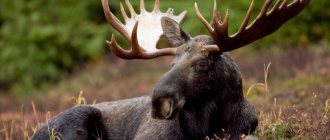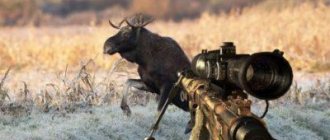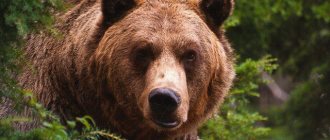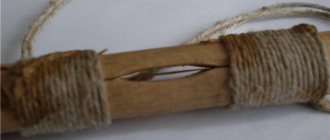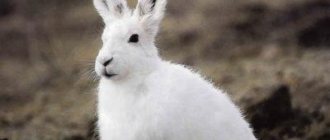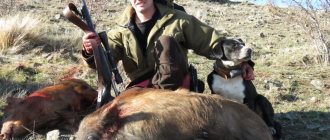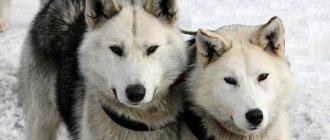Moose hunting takes place during the period when these animals begin their rutting season and are keen on mating games and procreation. At this time, moose, especially adult males, lose caution in the fight for the female and allow the hunter to discover them and come at close range.
In addition, this animal can be attracted by imitating the sounds of a rival or female. It is for this reason that this type of hunting, depending on the region, is called roar hunting, roar hunting, moaning hunting, or wabu hunting.
When do moose start to rut?
The elk rut occurs in the fall, usually when the first frosts arrive. It begins at the end of August - September and lasts about two months. Depending on the severity of the climate, the timing of the start of the rut shifts from the second half of August in the south to mid-September in the northern regions.
In Siberia and the Krasnoyarsk region. In Siberia and the Krasnoyarsk Territory, the moose rut begins mainly in September, although in their southern part this is possible even after the second ten days of August. The peak of the rut, depending on the latitude, usually occurs in the second ten days of September - early October. In the northern parts of this region, the rut can last until the first ten days of November.
In the Leningrad region and Karelia. In the Leningrad region and Karelia, the start of the rut usually occurs at the very end of August. Its peak occurs in the second ten days of September, when the maximum number of individuals is involved in the process, but it ends already in early November. This is due to the characteristics of this northern region in order to involve the maximum number of females.
In the Moscow region and in the middle zone. In central Russia and in particular in the Moscow region, the start of the rut usually occurs at the end of August. Here this period lasts on average about one to one and a half months and ends by mid-October.
In the Urals. In the Urals, the beginning of this period and its duration primarily depend on latitude. In the Southern Urals it is the end of August, and in the Northern Urals it is mid-September. The moose rut here lasts about two months and in the northern parts it can take place at the beginning of November.
In Belarus. In Belarus, the moose rut begins at the end of August, but more often it occurs in September - October. It lasts about a month and ends by mid-October.
In the Penza region. In the Penza region and other southern regions, the beginning of the rut occurs in the second ten days of August and lasts about a month and a half, dying out by mid-late October.
Duration
On average, the duration of the rutting period for moose is about two months. However, how long this period lasts, its beginning and end also depends on weather and climatic factors. So a sharp warming can delay its beginning, and a sharp cooling, on the contrary, push it to the beginning. Among other things, in young males the start of the rut is delayed by 15–20 days.
However, practice shows that once the rut has begun, it is not interrupted by any weather factors. Its duration primarily depends on the severity of the climate in the area. So in the northern regions it lasts for two and a half months, and some young males come to the wad at the end of November.
Important! According to the hunting rules, elk harvest is divided into three periods: for adult males from September 1 to September 30; for all sexually mature groups - from October 1 to December 31; for young animals up to one year - from January 1 to January 15.
Rutting and breeding of moose
In most cases, during the rutting season, moose travel in pairs, which is why many consider moose almost unconditionally as monogamous. However, moose monogamy is very conditional. According to observations at the elk farm of the Pechora-Ilych Nature Reserve, the estrus of elk cows (1952-1953) lasts only a few (2-5, more often 4-5) days. After the female begins to avoid mating, the male often looks for another female who came into heat later, thus changing several females during the rut.
Encounters near one female during the rutting period of several males—usually 2, and sometimes 3-4 and even up to 6—were noted more than once. In Buzuluksky Bor and the Pechora-Ilychsky Nature Reserve, in approximately 50% of all cases, a male went into the rut with one female, in 30% of cases, 2 males were encountered with a female, in 10% - more than two males, and in 10% one male was observed with several ( 2-4) females. On the farm of the Pechoro-Ilych Nature Reserve, there were cases when a male mated up to 7 elk cows during the rut and they all gave birth. Knorre (1953) believes that moose should be considered polygamous. However, if we take into account that the tendency towards polygamy can manifest itself in this species only under certain conditions: high population density and a sharp predominance of females in it (due to selective shooting of males) or when kept in captivity, it would be more correct to consider the moose as a limited polygamist.
Fights often occur between males over females, and in some cases they end in the death of one of the animals. Meeting moose during the rut or immediately after it with abrasions and scars on the body is quite common. There are known cases when one bull living with a female was attacked by several males at once.
Some moose pair up even before the start of the rut - in the second half of August. The male usually follows the female. He begins to vocalize—usually called a “moan”—before the females go into heat. The groan resembles a dull moo, it is much weaker than the roar of a deer and is usually heard no further than 0.5-1 km and only under particularly favorable conditions at a greater distance. Most often, the moan can be heard at dawn and in the evening, rarely at night and, especially, during the day.
Being in an excited state, the male breaks off branches with his horns and breaks the tops of small trees (such trees can be found before the start of the rut, when the elk cleans his antlers), sometimes knocks out holes with his hooves, eats the ground with the female’s urine; a characteristic odor remains in the place where the male was.
The female and especially the male lose their usual caution during the rutting period, the males become aggressive and allow humans to come close; the daily lifestyle of moose loses its regularity. A male in rut has tousled fur, his eyes are sometimes bloodshot, and his neck thickens. During the rut, males eat little and during this time they lose up to 17% of their live weight, counting from the former to the rut. The most aggressive males drive the calves away from the females during the rut, and they walk separately, only later joining the female. At the same time, in a number of areas, it is not uncommon for calves to be seen during the rutting period when females are with a male.
A female in estrus is covered by the male several times during the day. Mating occurs very quickly and lasts only a few seconds.
Read: Enemies, diseases, parasites, mortality and population dynamics of reindeer
The entire period of moose rutting, counting from the beginning of the moose to the last cases of mating, takes from 1.5 to more than 2 months. Mating is limited to a narrower period of time - within a month or so (the bulk of moose usually mate within 10-20 days), but individual moose cows (usually young, sick, etc.) breed much later. In the Lapland Nature Reserve, a newly born elk calf was discovered on July 4th. Pregnancy of moose cows lasts 225-237 days (Buzuluksky Bor and Pechoro-Ilychsky Reserve), in some cases no less than 240 days (Perm Zoo; Serpukhov Farm). Therefore, a cow moose calving so late must have walked between November 5 and November 20. In Quebec, Canada, a newborn elk calf was found on August 14, and the covering apparently did not take place until mid-December.
In the southern and middle parts of the range, the moose race takes place in a shorter time than in the north. After harsh and snowy winters and unfavorable summers (drought, etc.), the rut is less friendly than in normal years. The course of the rut is undoubtedly influenced by the nature of the weather in the fall, but indications regarding this are contradictory. The elk rut begins earlier and usually ends earlier in the southern and in some places (mainly within the European territory of the USSR) also in the middle parts of the range. The coverage of moose cows, at least in some years, takes place here already in the first ten days of September (southern Belarus, Moscow and Saratov regions, Buzuluksky Bor, Mordovian Nature Reserve, Rybinsk Reservoir, Sikhote-Alin), and in some cases at the end of August ( Saratov region). The moose run in these areas often ends at the end of September - beginning of October and much less often on October 10-15.
In the northern parts of the range, as well as in areas with a relatively harsh climate, long winters and late spring, mating usually begins no earlier than the second ten days of September, while mass coverage occurs from September 15-20 to October 5-10 (the northern part of the Scandinavian Peninsula, Karelia, Lapland, Pechora-Ilych and Kondo-Sosvinsky reserves, Demyanka river, Yakutia, northern Amur region, etc.). The moose race in these areas ends on October 15-25, but individual animals sometimes mate later. Later dates of the rut in areas with a cold climate should be considered as having arisen as a result of natural selection: with early rut and calving, the death of young animals in the event of a return of cold weather and from predators, especially bears, should be significantly greater than among those born at a later date.
It is very likely that the greater extension of the rutting season in some parts of the range, and therefore calving, also has an adaptive significance and is due to the variability of climatic conditions here in the spring. In relation to the Kola Peninsula, where the moose race is very extended, and the timing of snow melting fluctuates quite strongly, this conclusion suggests itself. The timing of the rut varies significantly from year to year. At the moose farm of the Pechora-Ilychsky Nature Reserve, mating of moose in 1952 was observed from September 23 to October 10, and in 1953 from September 12 to October 12.
With the exception of individual animals, probably from late calvings or those that were sick and developmentally delayed, all moose are usually capable of mating in the second autumn of life. However, under natural conditions, many females apparently emerge only in the third autumn. Males participate in mating females before 3-4 years only by chance, since they cannot successfully resist older bulls. In young animals, rutting en masse occurs at a later date than in older animals. In 1933, old moose in the river basin. Demyankas “chased” from September 22 to October 12, young ones from October 4 to 20.
Read: Field mouse (Apodemus agrarius)
Where moose are often pursued, calving often occurs in less accessible or remote and rarely visited places - in dense bushes or among young growth, sometimes along river banks, on swamps, islands and peninsulas, etc. In the Lapland Nature Reserve, moose calve everywhere : in swamps, near rivers, in forests, in burnt areas and even in mountain tundra (up to 500 m). If there is still a lot of snow during the calving period, then the moose cow gives birth in a thawed area. Before calving and in the first days after it, the female usually drives away the one-year-old, who remains nearby all this time.
The earliest calving occurs in the southern parts of the range and in some places (European territory of the USSR) also in the middle zone: from late April - early May and until May 20-25 (less often until the beginning of June). In some years, some moose cows calve here from the 20th of April and even at the beginning of this month. In the Moscow and Vladimir regions, most moose cows calve around May 1st. In the area of the Rybinsk Reservoir (Darwin Nature Reserve), moose calving occurs in May from the end of the first to the beginning of the second decade, but in 1951 a newborn calf was seen already on April 20. In the Saratov region, the first newborn calves were met on April 5 and 6 in 1946, and on April 1 and 4 in 1948; the latest calvings were observed here until mid-May.
In the period from the second ten days of May (in rare cases earlier) to June 10, moose calving occurs in the Pechora-Ilychsky Nature Reserve, Karelia, Yakutia and Western Siberia. On the moose farm of the Pechoro-Ilychsky Nature Reserve in 1952, moose cows calved from May 27 to 31, in 1953 from May 11 to 20. In the Lapland and Kondo-Sosvinsky nature reserves, as well as in the northern part of the Scandinavian Peninsula, the bulk of moose cows calve during the third ten days of May and the first half of June. In the Lapland Nature Reserve, two cases of moose calving are known in late June - early July. They should probably still be considered a fairly rare occurrence. Where elk make significant seasonal migrations, calving typically occurs in summer habitats, but after very snowy and long winters, often on wintering grounds.
A female moose gives birth to 1-2 calves. Two calves, rarely one, are typical for the Baltic states, the central regions of the European territory of the USSR, the Novosibirsk region, Cisbaikalia, the left bank of the lower Amur, the Okhotsk coast and Yakutia. Approximately equally often, both one and two calves are observed in Belarus, the Baltic states, the Lapland Nature Reserve, the Saratov region, Buzuluksky Bor, and in the river basin. Demyanki and, apparently, also in the Middle Urals. In the vast majority of cases, there is one calf and very rarely two in Transbaikalia, Dusse-Alin and Sikhote-Alin.
In the Lapland Nature Reserve, from the end of May to August inclusive, in different years, 25 moose cows with calves were encountered, of which 44% were twins and 56% were single. In Buzuluksky Bor over 5 years, moose cows with calves were seen 79 times: 42% had two calves and 58% had one. In one of the forestry enterprises of the Saratov region, out of 13 moose cows with calves observed in 1947, 6 had two calves each, the rest had one. In the Pechora-Ilychsky Nature Reserve for 1938-1946. recorded 108 meetings of moose cows with young ones; 47% had two calves, 53% had one. Of the 25 pregnant moose cows killed in the Novosibirsk region, 23 (92%) had two embryos and only 2 had one. Kaplanov (1948) met 23 moose cows with calves in Sikhote-Alin over 3 years, and all of them had only one calf; in rare cases there are two elk calves. Among moose in different parts of their range, from 10 to 25% of all moose with calves have two calves, the rest have one. In Sweden, one moose cow was found to have three embryos. Three elk calves with one female, as a great rarity, were encountered in an American elk.
Read: Types of moose
The uneven fecundity of elk in different parts of the range is obvious, but the reasons for this phenomenon are far from clear, especially since; that accurate digital data is not enough, and those that exist are not always comparable, since some authors took into account meetings of moose cows with their offspring only in the summer months, some for the entire year, which is less accurate, etc.
The ratio of twins to singles in a litter largely depends on the composition of the moose population; in addition, it fluctuates greatly from year to year. In the same area, fully mature moose cows often give birth to two moose calves, while young moose calves - one. In the first years after the organization of the Buzuluksky Bor reserve, young moose predominated in the population, as a result of which in 1933-1936. cases of twins in offspring were only 10-31%, in 1937-1940. their number increased to 45-57%. In the Pechora-Ilychsky Nature Reserve, there are from 1.2 to 2 calves per female with offspring in different years - more after ordinary and relatively light winters and less after heavy snowfalls.
In paired litters, elk calves may be male and female (47% of all cases), both male (30%), or both female (23%). The second calf in paired litters often dies. In Buzuluksky Bor, according to data for 7 years in May, the percentage of twins averages 57%; when determining their number for May - June - 52%, for May - September - 46%, for 12 months - only 40%.
Some moose cows remain barren. In the Primorsky Territory such cases are rare; in other parts of the range their number can reach 30-40% (Pechora basin) or more. Barrage, as a rule, becomes especially frequent in cases where moose hunting begins before the end of the rut and, in the event of a severe winter, is not stopped in a timely manner. American moose, as a rule, produce no more than 50% of all moose over two years old annually, and the rest every other year. In Newfoundland, Ontario and Alaska, the number of moose cows in the population reaches 60-65%.
Deer
Habits during this period
During the rutting period, the behavior of elk changes greatly, especially from the moment the females begin to become active. All this time he lets out his “moan” with enviable frequency. But when the bull catches the smell of readiness for mating left by the females, it begins to behave quite aggressively, showing its strength and “prowess.”
It breaks tree branches, tramples and rake grass, digging entire holes, especially in places marked by the moose cow. Its smell changes and intensifies, and its appearance becomes more massive.
Does a moose roar in rainy weather?
As stated earlier, the behavior of these animals does not depend on the weather.
For example, in rainy weather the activity of their calls does not decrease. It’s just that because of the noise of the elements, their groan is heard much worse, but its intensity remains the same. But in frosty, quiet weather, the roar of the elk becomes more active, since the sound at this time can be heard much further. Therefore, males begin to call more intensely to females and respond to the same calls from other males.
What time of day does it happen?
Studies have shown that elk roars have a fairly consistent daily frequency. During the day, moose usually rest. After the evening feeding, at sunset they begin to moan for about half an hour. Feeding then continues, after which, towards the end of twilight, a period of short roaring again follows. After midnight, the elk's moaning may resume briefly. The main time of roaring comes at dawn. It begins half an hour before dawn and can last, with breaks, until daylight. During the day, as a rule, moose do not moan.
How to find a moose
According to the testimony of both zoologists and game managers, the elk race mainly takes place in the habitats of females. These are meadow floodplains of rivers with oxbow lakes, thickets of willow trees, and the outskirts of moss swamps. Forest clearings and clearings in the initial stages of overgrowth, young deciduous plantings and young forests that have begun to overgrow burnt areas.
In populated areas, these can be edges remote from people, overgrown, abandoned fields and meadows, willows and shrubs in the valleys of rivers and streams. Rutting areas usually do not change from year to year. These rutting areas can be identified by broken branches, traces of horns on the bark of trees, ground trampled and plowed up by hooves with dug holes.
Is it dangerous
The main danger during the rutting period comes from mature, mature males. Although the behavior of the young becomes much more aggressive, they are not so recklessly rushing to any suspicious movement. Adult males, driving away competitors from their territory, rush to any suspicious rustling of branches, especially in their rutting areas. Having met a friend, the elk protects her from others, and again rushes into any danger without hesitation.
Find out where to shoot a moose to kill it.
Even the cracking of a twig under your foot, the noise of footsteps or the rustling of branches is perceived as aggressive. If the hunter accidentally reveals himself and does not react in time to such a throw from the animal, and this happens very quickly and unexpectedly, then he may well suffer under the hooves of an angry male. In fact, during this period, seasoned moose rush at anyone who comes into their field of vision and is even in the slightest degree perceived as a competitor.
Features of moose hunting
On the Internet you can watch a free video of exactly how hunting for an ungulate takes place. There are rules and specifics for searching for it, because the habitats of moose in the rut are different in other periods of the animal’s life.
Hunting dates
According to the law, moose hunting for adult males is permitted from 09/01–09/30; during this time it is strictly prohibited to kill females and moose calves. All groups of animals can be hunted 01.10-15.01, and in January only young animals up to a year are killed. In some regions, the duration of the hunt is limited to 90 days. If we are talking about trophy hunting, which is carried out for beautiful antlers, it is usually carried out 01.09-30.09.
Hunting time
How to properly prepare for a hunt? First you need to purchase a license, otherwise hunting will be considered poaching. The ideal time to search for an animal is early morning or evening - then moose are active in relation to females. In the wind or rain, attempts will be unsuccessful - the animal will hear and smell the hunter.
Hunting places
Every year, the places where the animals “get to know each other” remain the same; they constantly return to the same areas. There is no point in choosing open areas; the moose will not come here. Signs of a moose current:
- trampled clearings with “bald” areas;
- sour smell floating around;
- broken branches, trees;
- antler marks on trees;
- dug holes.
In harsh areas, animals prefer to roar along the outskirts of moss swamps, in dense forest young growth, along overgrown hayfields, floodplains of rivers and streams. In mountainous areas, moose gather in intermountain valleys, floodplains, and along the banks. In sparsely populated areas, animals prefer river shallows and islands covered with pebbles.
Listen to the roar of an elk during the rut
The roar of an elk differs sharply from the roar of a red deer or deer. It is not for nothing that it is called a groan, since it is weaker and looks like something between a moo and a sad sigh. This sound is difficult to hear at a distance of more than a kilometer.
Sound: Decoy for elk during the rut
Moose roar
Voice of a male moose
The voice of a female moose in the forest
How the elk roars
Sound of a moose
How to lure a moose correctly
Once a moose's breeding area has been discovered, the easiest way to get it to shoot is to lure it there by making sounds of an opponent or a female. In addition to the voice, it is advisable to rustle branches and bushes, stomp, tap and scratch the bark of a tree, imitating the sounds of an elk breaking through the forest.
Voice and hands
If you want to call a moose, it is best to imitate the call of a young male. Other bulls respond to such a groan much more boldly. By the beginning of the rut, some males do not have a mate, so they more actively follow this sound, wanting to find a free female or fight her off from another.
The sound itself resembles a muffled groan, turning into a restrained roar. It is quite possible to learn to imitate it with your mouth; the secrets here are not so much in the technique of execution, but in the presence of hearing and some abilities. At the same time, they help themselves by pinching their nose with their index fingers, folding their palms into a mouthpiece and changing their position to change the volume and tone of the sound.
Video: How to lure moose during the rut
How to learn to roar like a moose
If you listen carefully to the roar of a rutting elk, you will notice that during this period the groan of adult bulls is similar to the sound of “oo-a” or “oo-o”; it is a dull roar. But the moo of young males sounds like “oh-uh”, its timbre is vibrating and rattling. During the rutting season, you can also hear the cry of a moose cow. This sharp sound, similar to a neigh, is often a response to the bold actions of a bull.
Read about how to hunt elk from the approach in winter.
On the waboo
It is much easier to call a moose using a waba - a special decoy. You can either purchase them or make them yourself.
How to make a moose waboo with your own hands
The simplest waba is made from a tin can. To do this, it is advisable to use not an ordinary tin can, but a can with a removable tin lid, from coffee, baby food, etc. The main thing is that the diameter of the upper hole, due to the rims, is slightly smaller than the diameter of the can itself. In addition to it, we will need a lace or nylon rope, 50–60 cm long, electrical tape or a piece of leather.
The waba is done simply:
- A hole is made in the center of the bottom of the jar so that the existing rope fits tightly into it;
- We pass the rope inside and tie a knot at its end that prevents it from falling out of the jar;
- To make the sound of the vaba muffled and not cause metallic rattling, the walls of the jar can be covered with electrical tape or leather;
- Waba is ready.
How to attract you:
- The rope is wetted;
- The jar is taken with one hand by the base;
- With the other hand, pass along the rope from top to bottom, holding it tightly with two fingers.
In this case, the rope serves as a resonator, and the can as a speaker. You can find the desired timbre by filling a jar with moss. The smaller the diameter of the can, the higher the sound produced.
Video: How to lure a moose to a waboo
Elektromankom
Another convenient way to lure elk is an electronic decoy. This is an industrial device powered by batteries, in which a music library of various sounds made by moose is recorded: adult and young males, females in search of a male and during mating, the sounds of a fight, the roar of a rival male, etc.
However, when purchasing such a decoy, you must definitely listen to how the moose roar in this music library to make sure that the sounds are naturally similar. Often devices made for hunters in other countries are not very suitable for ours, since the sounds made, for example, by Canadian moose, are different from domestic ones.
Moose hunting "in the rut"
Probably, with a great deal of truth, we can say that summer-autumn hunts, at least in the first half of the season, take place under the sign of birds, while the shooting of animals at this time is limited. Until October, the list of game hunts is really not long: bear and wild boar in the fields from ambushes, and deer and elk “at roar” - that’s probably all. Bull moose hunting will be discussed in this essay.
Signs of elk rut
For all deer living in our country, the mating season occurs in the second half of the year. The rut of roe deer begins earlier than everyone else - from the end of July to the end of August; The musk deer are the last to “chase” - from late November to mid-December. The rutting time of elk and red deer, including maral and wapiti, roughly coincides; the first signs appear at the end of August, and everything ends by mid-October. The almost two-month extension of the rut applies to populations of these animals as a whole, because animals living in the southern parts of the range begin earlier, and in regions with a harsh climate - about two weeks later. For the middle zone (in the latitudinal dimension), the most active part of the rut occurs in mid-late September.
It must be said that literature (I don’t mean scientific) and fine art have always paid much more attention to the red deer than to the elk. And this is true: a slender, handsome man in a challenging pose, with an elongated powerful neck, an elegant head, decorated with horns of extraordinary beauty thrown back, is much more suitable for the role of a model than a powerful one with a heavy hook-nosed head, horns of not always a certain shape, clumsy at first glance elk figure. Nevertheless, hunting for it during the rut - “to roar”, or, as they also say, “to groan” - is unlikely to be inferior in emotionality to that of a deer. Moreover, at this time an elk can pose a very real danger to the hunter.
Adult, sexually mature bulls strive to find a mate even before the start of the physiological rut, and until the end of the moose cow's estrus, they are together. Then a moment comes when she rejects the “advances” of her boyfriend, and he can go in search of a new girlfriend. Unlike red deer, bull elk do not create “harems,” and the presence of several females with one bull is unusual, although such facts have been noted.
Purely externally, a bull’s readiness for the rut can be determined by its horns. If they have already been cleared of the skin and fur and acquired a normal “bone” appearance, then his body has already begun or is about to begin producing sex hormones. However, the bull becomes fully ready for mating only when the moose cows come “in heat.” The secretion secreted by their genitals falls onto the soil with urine; the bull finds this place by smell and becomes excited. He breaks branches, sometimes the tops of young trees, rakes and beats the grass to the ground with his hooves, especially where the moose cow has urinated. Such places are called “points”, and they can be up to two meters in diameter. At the same time, physiological processes are activated in the body, making it ready for mating. Not only the behavior, but also the appearance of the male changes contrary to the usual. The eyes become bloodshot, the neck becomes thicker, and it seems that the entire front part of the body is increasing in size. It emits a sharp, specific smell that is difficult to describe, but the smell of a mighty beast is unmistakably discernible in it, and a feeling of danger involuntarily appears.
Throughout the entire rut, the bull gives voice. The sound it makes is not at all like the roar of a red deer. This is something between a grunt and an exhalation of relief with a voice. This sound is most accurately characterized by the name that our ancestors gave it - “moan”. It is much weaker in strength than the roar of a deer and is rarely heard from a distance of more than a kilometer, although the ability to hear it is greatly influenced by the terrain, density of plantings, and extraneous sounds (wind, sound of water, etc.). The greatest activity in vocalization is observed at dawn and in the evening closer to sunset; Hearing a moose during the day is a rarity.
For mating games, moose choose a variety of places. This is largely determined by the terrain and the nature of forest plantations. In the northern regions of the European part of Russia, they prefer to “moan” along dry manes and edges of moss swamps, in dense young growths of old clearings, along overgrown forest hayfields, as well as in the floodplains of forest streams and rivers. In the mountainous regions of Siberia and the Urals, where the permanent habitats of moose are limited to river floodplains and intermountain valleys, breeding areas gravitate towards river banks. The same can be said about the plateaus of Central Siberia and Transbaikalia. In places almost never visited by people, where there is no need to constantly hide in the thickets, elk are especially fond of the wide pebble beds of small rivers with forest islands, which in September literally exude the “rutting elk spirit,” making a person who suddenly finds himself there not for hunting reasons feel feeling very uncomfortable.
Hunting "for the roar"
By tracks, “dots”, broken branches and trees, by the voice given and the smell, you need to find the place where the animals are “chasing”, i.e. where the bull feels like the master of both this place and the female who is with him. Raising his voice from time to time, he warns possible rivals that everything is busy here and he will not allow the presence of a stranger. The hunter’s task is to imitate the “moan” of the alien, to irritate the owner bull, make him believe in the appearance of a competitor and lure him to a clear place for a shot.
Not all bulls have girlfriends at the beginning of the mating season, and these bachelors are constantly in search, wander widely - you can meet them in different places. They also raise their voices, trying to find out where the “lucky guy” is in order to try to take the female away from him, or whether there is a free cow nearby. Such animals boldly follow the voice of a “cabber” - a hunter imitating the “moan” of a bull. Luring a bull is not limited to just giving a voice, but is accompanied from time to time by the cracking of broken branches and the tapping of a stick on a stick or tree, which should be perceived as the knocking of the horns of an excited bull on trees. In general, the “moan” is formed by the whole complex of sounds that the elk produces.
Nowadays, more and more often, roar hunting is of a trophy nature. Animals in their prime have well-developed horns, i.e. at the age of 6-12 years. An experienced “cabbler” can distinguish an old animal from a young one by its voice and, based on this, build a hunt. Of course, it is best to start luring a specific elk, which is known from pre-hunting reconnaissance. If the hunt begins with a search, then when you hear a “moaning” bull, try to get an idea of the age of the animal. When a mighty animal gives a voice, there is a greater chance that he will accept the challenge and go to drive away the bull, which, based on his voice, seems weaker than himself. A medium-sized elk is unlikely to rush at a potential rival if you imagine him in the voice of an old animal; rather, he will try to quietly leave and take the female away. When trying to lure a bull away from a female, you need to be patient, because he is reluctant to leave her, preferring to call roll at a distance. It can be easier to lure a wandering loner.
It happens that with one cow there are two, and sometimes three bulls. Or rather, next to her is one of the strongest, who does not let anyone in, and the rest are nearby, but at a safe distance. In this case, the hunter is often approached not by the main contender, but by one of those nearby who is clearly inferior to the owner in size and strength. Therefore, when beckoning an elk, you need to try to determine by the response voice whether the hunter is dealing with one or several males, and depending on this, decide whether to shoot at the first animal that appears or try to take the best trophy. It often happens that a large bull cannot be lured away from a female, especially if there are other males nearby, and then you have to change the hunting location and look for another suitable one.
Many people believe that during the rut the aggressiveness of bulls prevails over caution, but it seems to me that this is not so. Sometimes you hear stories about how someone walks through the forest without hiding, with a bang, and suddenly an elk flies out and, seeing a person, does not run away, but demonstrates its aggressiveness. Rather, this can be explained by the fact that a man noisily walking through the forest sets the elk up against an approaching rival, who in nature behaves noisily, showing his strength and confidence. Try not to attract, but to hide the “moaning” animal, and you will immediately feel how wary he and the female are to the slight noise made by the hunter when approaching. Moose, as a rule, react to quiet sounds that are incomprehensible to them by leaving the place. We must not forget that during the rut, moose are hunted not only by people, but also by bears, encounters with which do not bode well for them. It’s probably worth reminding that neither the “cabbler” nor the shooter should make any other noise other than the simulating action of a bull.
When choosing a position for luring and shooting, you must remember that the animal must pass through at least a relatively clean place in order to be able to target the killing area. As in any other case, you cannot shoot through thickets (branches, bushes, grass, etc.). What weapon can be recommended for such a hunt? From rifled - better than 9 mm caliber. These can be carbines chambered for 9.3x62, 9.3x64, 9.3x57 foreign-made, 9.3x64 and 9x54R domestic. A combined weapon is preferably with a rifled barrel chambered for the 9.3x74R cartridge or the above-mentioned domestic cartridges. It is better to use 12 gauge smoothbore weapons with cartridges loaded with heavy Brenneke-type bullets. All the cartridges that have been mentioned have sufficient killing and stopping power for such an animal as a bull elk during the rut, and I took the liberty of recommending them for the following reasons. Firstly, by the time of the rut, elk reach their highest fatness, and among bulls actively participating in the rut, specimens over 400 kg live weight are not uncommon; secondly, the cartridge must provide a reliable kill, because hunting takes place during the snowless period, and catching a wounded animal without dogs in the autumn forest, and often at dusk, is not at all an easy task; thirdly, by the time of the rut, animals become especially strong against wounds, since all the body’s reserves are mobilized to continue the race. It is advisable to equip the weapon with an optical sight, because you often have to shoot in low light, although the shooting distance rarely exceeds 60-70 meters.
Is a wounded moose dangerous?
A wounded animal is always dangerous. The only question is how active this beast is. Most likely, it depends on the nature of the particular animal. I have long ago determined for myself that wild animals that are quite highly organized mentally, just like domestic animals, are completely individual and have their own character (remember our beloved dogs). Some are recklessly brave, others are cautious, cunning and treacherous, others are downright cowardly, etc. And there is a lot of evidence of this in hunting practice. I killed about a dozen moose during the rut; among them, unfortunately, there were also wounded animals that had to be collected, but only one showed me what a wounded moose could be like.
This happened at the end of September 1975 in Evenkia on the Oskobe River, the left tributary of the Podkamennaya Tunguska. Our camp was located 40 kilometers from the mouth. One day I had to go up the river another 20 kilometers and, in particular, take two beautiful huskies - Choka and Varnashka - to the owner, full-time hunter Pyotr Zizevsky.
It was the height of the moose rut, the animals stayed close to the river, we had already caught several animals and sent them to the fur farm. For those who do not know, I want to explain that in such remote areas for the needs of fur farms, shooting elk and reindeer was allowed from July 1, and there was no shortage of licenses. But that time I did not intend to hunt. I had with me a Sauer three-barreled gun with two upper barrels of 12 gauge and a lower rifled one chambered for the 8x57JR cartridge. For the upper barrels I had several cartridges with shot and two with Brenneke bullets, for the lower barrel one normal cartridge and two weakened ones, especially for wood grouse. However, as they say: “We propose, but the Lord disposes.” The river is narrow, the boat was moving slowly. The dogs lying in the bow became wary, turned their noses and jumped into the water (a familiar thing for them), a minute later they were on the shore, and a little later they were barking only two hundred meters from the river.
Seduced by the apparent ease of prey, he pulled the boat to the shore, took off his sheepskin coat (at the end of September in those places, and even on the boat, it can be very cold) and, wearing only encephalitis, set off to bark. Apparently, I was not careful enough in my movement, and maybe the animals were wary of the sound of the engine, but the barking stopped and resumed a couple of minutes later, and so on three times. In general, the animals and dogs took me one and a half to two kilometers away from the river. I caught up with them in a sparse, oppressed larch forest with trees no thicker than 8-10 cm in diameter. The moose, and it was a very large bull and a cow to match, allowed me to approach about 20 meters. The cow stood calmly, a little to the side, and the bull was spinning around with the dogs. The first shot from the smooth trunk was at a cow; it did not fall immediately, but, having bounced back a little, disappeared behind a small larch curtain. Confident of a good hit, I switched to the bull and shot him in the heart area, also from a smooth barrel. Without a bullet! After the shot, he quickly rushed at the dogs, forcing them to jump back 20-25 meters, and turned in my direction. I only had one cartridge left in the lower barrel of the tee. Surprised by the ineffectiveness of the first shot, I was in no hurry to shoot anywhere and waited for the moment when I could shoot at an absolutely lethal place. But it was not there! He flew at me with his head down, somehow strangely throwing his front legs slightly to the sides, putting his shovels forward. I’m writing now, and the picture is before my eyes. I’m squeezing a tee with one cartridge, but there’s nowhere to shoot. The hump of the withers rises between the horns; if you hit the spine, it will collapse, and if not, it will not even stop. Another forehead, but even this target is difficult for a running animal to hit. I understand that I need to shoot, but I can’t bring myself to take an uncertain shot. Further - worse! Having not reached me about 10 meters, he rose on his hind legs, not to a vertical position, but stopped halfway up the rise, and moved towards me on his hind legs, like a boxer, throwing forward either his right or left front legs. His head is in the same position: the muzzle is lowered and covers the chest, the horns are forward, but the hump of the withers is no longer visible, the front hooves are at the level of my face. There is nowhere to shoot except the forehead. The gun has long been at my shoulder, I catch the dangling forehead on the fly, almost shoot, but the animal suddenly drops sharply on its front legs and turns 180 degrees. Dogs! Unexpected grabs on the hind legs made the bull mistaken and believe that the enemy behind was more serious. He again rushed at the dogs. I took a breath and, choosing the moment, shot him at the base of his neck. He fell without taking a single step, but not on his side, but, having broken all four legs, on his stomach. I didn’t go up to him right away, but stood there and reloaded the gun with what I had. The dogs tore the elk from the back, stuffing their mouths with hair, and then coughed for a long time. The bull was truly great. Butchering two elk (a cow was found about 150 meters away) and transporting them to the camp took almost two days. Later, local fur hunters told me that you should never shoot a cow in front of a bull, because it “gets wild” very much. I don’t know if this is actually true, but I never had a chance to check it again, and I probably wouldn’t. But since that incident I have treated elk with respect, and when hunting alone, especially when catching a wounded animal (and not only during the rut), I take precautions. And I recommend it to everyone.
Alexey Sibirsky
Moose hunting with dogs
During the elk rut, you can also hunt it with dogs. For this purpose, specially trained huskies are used. Such a dog must have a number of certain qualities, be strong and resilient in order to search for elk over a large area, and especially to chase it for a long time over long distances at a decent speed.
Having found the animal, she must bark at it, as if reluctantly at first, but under no circumstances rush at it, otherwise it will run away very quickly and over a great distance. The dog must be able to dodge the attacks of the beast, since it can kill it with one blow of its hoof.
The hunt itself takes place in the following order. The hunter goes to the elk's racing or feeding areas, after which he releases the dog. She is looking for the animal, and having found it, without rushing, she begins to bark at it gradually, but with increasing pressure. The dog's task is to keep the elk in one place until the hunter approaches, and to distract him until the shot is fired. In case of escape, the dog chases the animal until it stops in a new place, where everything starts anew.
Elk: roar hunting
photo: Fotolia.com
At night and during the day, moose activity subsides; the best time for hunting is evening or morning dawn. The ambush should be arranged a couple of hours before dawn or in the evening before dark.
Shooting at dusk is not easy, before you pull the trigger, make sure that the shot goes straight to the elk, never shoot at noise or at a target that is not clearly visible.
The gun must be ready to fire and the safety is off; the slightest click can ruin the hunt, so remove the gun strap and secure the rattling swivels. Special devices will make it easier to aim in the dark.
ON THE MOAN
Uloma, SBI farm, which has proven itself to be successful in hunting trophy elk. The path to the hunting grounds was not close, but there was no opportunity to waste time on rest, and in the UAZ of the head of the farm we went to the neighboring village to the most experienced huntsman, an expert in roar hunting, Anatoly. His excellent knowledge of the lands, habitats and habits of elk is the key to a successful hunt.
Having quickly gathered himself, the huntsman asks himself: five kilometers through the swamp and an excellent trophy, or a five-minute walk from the car, and antlers with five shoots will decorate the wall. Despite being tired and having little time until evening, we decided to walk five kilometers through the swamp.
The dry autumn has dried out the cranberry bog, our feet hardly get stuck in the light green moss, so Nikolai and I are pleasantly surprised by the relative ease of the transition, and after an hour and a half we are already at the mane in the middle of the moss, overgrown with oppressed small pines.
Read the material “Act correctly in case of an accident with a moose”
Putting a finger to his lips, Anatoly asks for silence. Hiding behind the juniper bushes near the inverted pine tree, we wait for the evening dawn. Flocks of mallard ducks fly overhead, hurrying to the fields of unharvested barley on the edge of the swamp where we left the car.
Dusk crept up unnoticed, at first long shadows from the pine trees lay on the moss, and then only the tops of the trees were captured by the glow of the crimson sunset. A muffled sigh “o-o-oh, o-o-oh”, turning into a soft moan, then the rumble of horns on the branches of trees made the heart beat with such force that each beat was heard as a wheezing in the throat, lips were dry, the palms of the hands squeezing the forend and the neck of the stock, covered with sweat.
Anatoly “moaned” nearby, so much so that the surprise and authenticity of the sound made his hair move under his hat. The bull responded with a furious groan, and Anatoly fell silent, gesturing to be ready to shoot, which was already clear.
My friend froze with a digital video camera in his hands, set to night shooting, the slight shaking of which indicated his excitement. The elk walked carefully through the thickets, stopped, apparently listening, and then continued moving, becoming more and more excited as it approached the imaginary opponent.
Read the material “You will have to pay for a downed elk calf”
Here he is very close, branches from the bushes fly to the sides under the blows of the mighty horns, the hooves of the front legs are overpowering - and tufts of moss shoot up to the height of the beast. Nikolai can’t stand it, turns on the camera and, in the heat of cinematic frenzy, rises slightly to better capture the frame. The blind elk mistakes this movement for an opponent and attacks with a dull groan.
“Shoot,” Anatoly is already shouting, and even without this the elk is already at my gunpoint, and the sudden firmness in the sight allows me to make a fairly accurate shot, taking into account that the bull was walking at bayonet point with his head down.
Realizing that he had made a mistake, the elk spun around, breaking pine trees and crushing junipers, turned his side, and the second shot was exactly in the right place. Burying himself with one shovel in the soft moss, the forest giant became simply a trophy. Nervously reloading the gun, for some reason I count out loud the shoots on a wide shovel: one, two, three... nine.
Yes the horns are really good. Nearby, a nervous Anatoly and a frightened Nikolai, who still hadn’t turned off the video and continued filming. This is truly a real hunting adventure.
WITH LAIKA
Dogs are used when hunting elk in the following cases: they are used to search during driven hunts, and they, together with the beaters, put elk to numbers. The dogs find and begin to bark at the elk, delaying the animal and diverting its attention, which allows the hunter to approach the shot; the elk are almost not afraid of dogs and do not leave annoying guests.
Read the material “Moose on the road: dangerous situations”
Used to search for wounded animals, the dog’s task is to find, stop and hold a wounded elk until the hunter approaches. In the first case, they mainly use hounds and huskies; in the second and third options, of course, a better husky dog cannot be found, although there are supporters of the use of continental pointers.
An interesting hunting area at the junction of three regions - Moscow, Yaroslavl and Tver. There are two of us, and there are also two licenses. Today my partner, local game manager Victor, owner of a pair of West Siberian Laikas.
| photo: Fotolia.com |
Yesterday was an unlucky day, and not because the dogs did a bad job, rather the opposite, because you can’t explain to the pointy-eared dogs that we are hunting elk and not other game. It would seem that we were lucky; we quickly came across fresh moose tracks and, having let the dogs loose, we literally immediately heard the barking of our four-legged helpers.
With all precautions, we hide the animals that have been put on hold, which is quite labor-intensive in deep snow, and maintaining silence at this moment makes the whole process not only interesting, but also protracted. Imagine the disappointment when the elk turns out to be a hefty deer, having so unsuccessfully followed the tracks of the elk.
With difficulty we call back the dogs that had tagged along with the wounded deer, return to the skis left behind before the start of the hide and go to another block - away from the deer crossings. We crush the snow with wide skis for an hour, and finally, under the ski track there are prints of moose hooves.
Read the material “How we went to kill an elk”
The huskies followed the trail, and everything was repeated down to the smallest detail, except that before we began to approach the animal, as it later turned out, again to the deer, we had to circle around the forest for a couple of kilometers, and yet there were no other traces except our elk came across. Some kind of mysticism, it’s just a pity that there was no license for the deer.
Although today was a bad day, I had a lot of fun watching the dogs work, and in the wilds it’s quite rare to see a deer, so the day wasn’t wasted. Tomorrow we decide to go to abandoned peat mines, separated by ditches that are overgrown with willow bushes, small birch, alder and aspen.
An excellent food supply for moose, but overgrown reeds and an abundance of marsh plants made these lands attractive not only for elk, but also for wild boars, who have trampled deep trenches in the snow.
I look into the intelligent eyes of a gray dog. I’m trying to “talk” him - we need moose, today wild boars are not game, you understand. As if heeding my admonitions, the usually stern male stands on his hind legs and licks me on the cheek, saying, don’t be afraid, we won’t let you down.
Read the material “Moose. Gon. Video."
The dogs are set out to search, half an hour passes, one husky appears and, looking sideways at the owner, shows with all its appearance - we are looking, don’t worry, everything is in order. Disappears in the reeds. Another forty minutes of waiting and a distant bark notifies that the beast has been discovered.
Dry reeds and frequent chalk grass make it difficult to move silently, and low-growing vegetation forces you to hide in a half-bent position, but from a distance, as if in the palm of your hand, the work of huskies is visible.
One elk practically does not pay attention to the annoying animals that have appeared out of nowhere and continues to carefully “trim” the tops of the bushes, the other behaves extremely aggressively, lunging with the hooves of its front legs. Laikas arrange such a carousel under the nose of the elk that it is not clear how they manage to dodge the blows of the angry beast.
Sensing our approach, the dogs began to cry even louder, distracting the attention of the moose, pressing on them more seriously, and already the second moose, having given up eating the bushes, took up a fighting position. This reaction of moose to the behavior of experienced dogs allows them to get closer to the shot.
The hunter points with his hand - the left one is mine, and our shots sound almost simultaneously. Now to the base to get the horse, the snowmobiles broke down during the season, and all that was left was hope for one horsepower.
Yuri Konstantinov September 25, 2021 at 1:40 pm
Visiting salt licks
One of the places where there is a high probability of tracking an elk is a salt lick. Salt is an excellent bait. With its help, these animals replenish the lack of minerals in the body, especially in the spring, and accumulate in the fall in preparation for winter nutrition. The easiest way is to create such a place yourself. To do this, make a large feeder into which rock or iodized salt is poured.
Gradually the moose get used to visiting this place. This is evidenced by their tracks on the ground and surrounding bushes and trees. Moose and salt licks come most often at sunset. First, he listens for about 15 minutes, standing in the thickets, and then goes to lick the salt.
Hunting in salt licks is carried out from a blind spot or storage shed. Place it higher on thick trees. This is due not only to the danger of the elk itself, but also to the possibility of other animals, such as a bear, visiting the salt lick.


